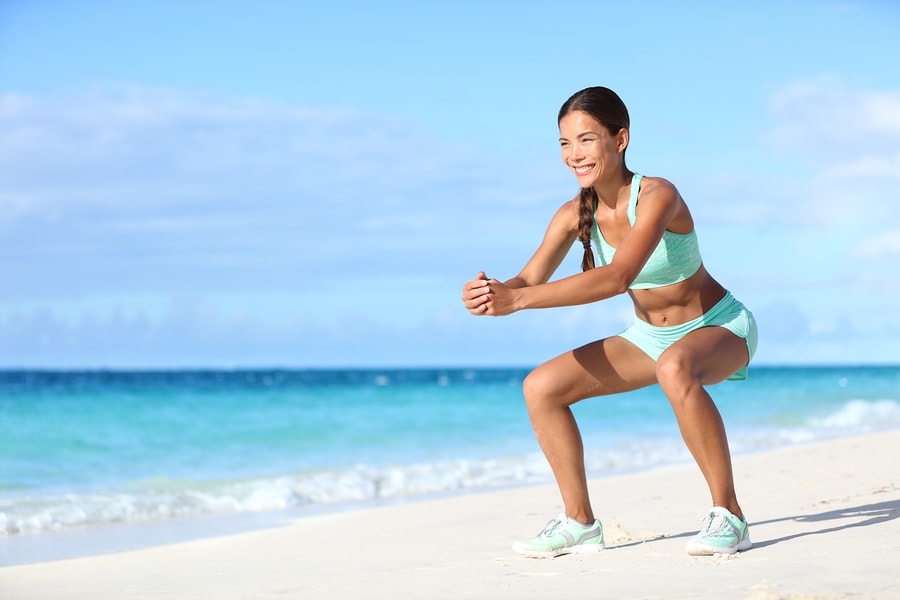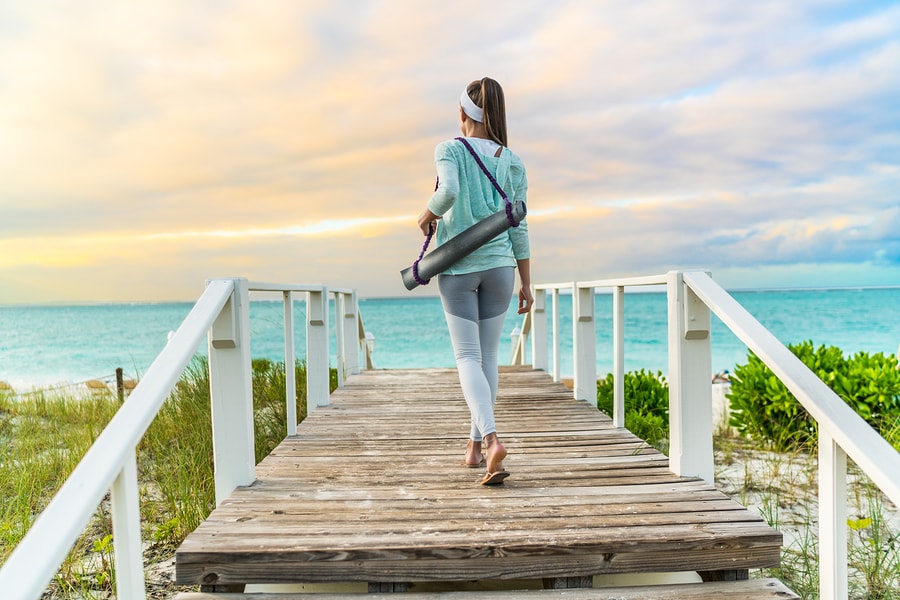Exercise For Restless Leg Syndrome
1. Calf Stretch
The calf stretch is an excellent way to relieve the symptoms of RLS and make your calves more flexible. To perform this exercise, stand two feet away from a wall and then place your hands and left toes against the wall. Then push your hips forward to stretch your calves and hold the stretch for 30 seconds. After 30 seconds, switch the position of your feet, so that your right toes are against the wall. Then push your hips forward and hold the stretch for 30 seconds. As you get more experienced, try to hold the stretch for longer to further improve your flexibility and manage your restless leg syndrome.
2. Cycling
Cycling is another brilliant exercise that reduces symptoms by getting your legs moving. It also improves your cardiovascular fitness and flexibility. Plus, it allows you to top up your vitamin D levels by getting outside. For the best results, try to cycle for a least 30 minutes each session and extend the length of your cycling sessions as your fitness improves.
3. Hamstring Curl
The hamstring curl is a resistance based exercise that strengthens your hamstrings to minimizes the symptoms of RLS. To perform hamstring curls, grab a set of ankle weights and wrap them around your ankles. Then kneel and lean forward, so that your knees are bent at a 90-degree angle and your arms and back are straight. After this, straighten your left leg out behind you, so that your ankle, knee, and hip are aligned. Bend your knee and curl your ankle towards your butt until it’s contracted. Then extend your leg and return to the starting position. Repeat for 10 repetitions, then switch legs and perform 10 hamstring curls with your right leg. As you get more experienced with hamstring curls, try adding extra resistance… Or do more repetitions to build strength in your hamstrings.
4. Hamstring Stretch
The hamstring stretch is a fantastic way to keep your hamstrings flexible to offset the symptoms of restless leg syndrome. To perform this exercise, sit on the floor with your legs straight out in front of you. Then lean forward with your hands until you cannot stretch any further and then hold this position for 30 seconds. As you get more experienced, try to hold the stretch for longer to further improve your flexibility and manage your restless leg syndrome.
5. Leg Extension
The leg extension builds strength in your quadriceps and also helps to treat the symptoms of restless leg syndrome. To perform leg extensions, grab a set of ankle weights, wrap them around your ankles and then sit on a chair. Extend your legs until they are straight without locking your knees. Then lower your legs back down to the starting position and repeat for 10 repetitions. As you get more experienced with leg extensions, try adding extra resistance or performing more repetitions to build strength in your quadriceps.
6. Squats
Squats are one of the best leg strengthening exercises to target your hamstrings, quadriceps, and calves. They also have a positive effect on restless leg syndrome. To perform squats, stand with your legs shoulder-width apart and clasp your hands together in front of your chest. Bend your knees while keeping your back straight and lower yourself down until your knees are bent at a 90-degree angle. Once your knees reach this position, slowly raise yourself back up to the starting position and repeat for 10 repetitions. As you get more experienced with squats… Try adding extra resistance or do more repetitions to build strength in your legs.
7. Step Ups
Step ups are a simple but effective way to improve both your cardiovascular fitness and your leg strength. They also keep the negative symptoms of restless leg syndrome at bay. To perform step ups, grab a stable chair that will hold your full body weight without collapsing or wobbling. Place your right foot on the chair while leaving your left foot planted on the floor. Then raise your left foot off the ground, step up, touch it against the top of the chair and drop back down. Repeat for 10 repetitions, then switch legs and perform 10 step ups with your right leg. As you get more experienced with step ups… Try adding extra resistance (by wearing ankle weights) or do more repetitions to build strength in your legs. Try stepping up at a faster rate to improve your cardiovascular fitness.
8. Swimming
Swimming is a gentle, low-impact cardiovascular exercise that gets your entire body moving. The resistance of the water also makes it a great exercise for building strength and getting a full body workout. For the best results, try swimming for at least 30 minutes each session. As your fitness improves, try increasing the intensity at which you swim and extending the length of your swimming sessions.
9. Walking
If you’re not a fan of cycling or swimming… Walking is a fantastic way to get moving and minimize the severity of your restless leg syndrome. It’s low impact but does a great job of improving your cardiovascular fitness and also allows you to get outside and top up your vitamin D levels. For the best results, try walking for at least 30 minutes each session and extend the length of your walks as your fitness improves.
10. Yoga
Unlike all the other exercises on this list, yoga tackles restless leg syndrome in two distinct ways. First, the flexibility side of yoga physically relieves the symptoms in a similar way to the stretches discussed above. Secondly, the meditative side of yoga helps reduce your stress levels. Stress is a known trigger for restless leg syndrome. By lowering your stress levels, you can lower the impact of stress on your restless leg syndrome. For the best result with yoga, try joining a class. Not only will this keep you motivated but it will also ensure that you’re practicing yoga regularly.




 Natural Remedies For Restless Leg Syndrome
Natural Remedies For Restless Leg Syndrome
Hi Jackie,
This is the first time I heard about RLS. Although I do not have this syndrome, I am very glad to learn about it. We never know what comes next, since I am not getting any younger.
Regardless, the 10 exercises tips you mentioned are good for our overall health.
Stay Healthy!
Sharon
Hi Sharon! Thanks for connecting and sharing!
Hey Jackie,
Nice post on exercises for restless leg syndrome. I do a couple of these exercises a week. I usually workout 3 days a week and sometimes I may do 4. I hate doing squats but if it helps with restless leg syndrome then so be it.
Thank you for the nice informational post. I learned a lot from reading it.
Hey Kendrick… Thanks for taking the time to acknowledge the post and connect. So great!